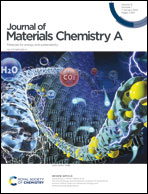Damage restoration in rigid materials via a keloid-inspired growth process†
Abstract
Living organisms can self-heal wounds in their rigid and strong bodies via the growth of keloids. In contrast, it is still challenging for current self-healing strategies to efficiently self-heal catastrophic damage in rigid materials without compromising intrinsic mechanical properties. Inspired by the formation of keloids, we here report a novel growth-induced self-healing strategy for restoring heavy damage in rigid polymer materials. This strategy is based on the combination of traditional extrinsic and intrinsic self-healing mechanisms and involves in situ polymerization to form new matrices in damage regions as well as chain exchange on the interface between original and newborn polymers to integrate the matrices. We demonstrate this strategy using rigid crosslinked copolymers made from 2-hydroxyethyl acrylate and 2-hydroxyethyl methacrylate (P-HEA-co-HEMA). The copolymers show a high Young's modulus up to 1.0 GPa but can still self-heal with a high efficiency of 86.1% even when the damage region almost destroys all the mechanical properties. Since both in situ polymerization and chain exchange reactions are common in different polymer material systems, we thus envision the great potential of our growth-based strategy in designing high-performance self-healing materials.



 Please wait while we load your content...
Please wait while we load your content...